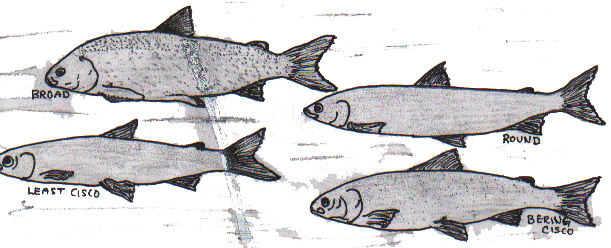 Marshall
Cultural Atlas Marshall
Cultural Atlas
This collection of student work is from
Frank Keim's classes. He has wanted to share these works for others
to use as an example of Culturally-based curriculum and documentation. These
documents have been OCR-scanned. These are available
for educational use only.
Whitefish
Whitefish are the most abandant group of fish
north of the Alaska Range, inhabiting almost every type of river or
freshwater habitat in this section of Alaska.
There are seven different types of white fish:
Broad, Humpback, Pygmy, Round, Least Cisco, Bering Cisco, and Arctic
Cisco.
The Broad and Humpback whitefish are referred to
as true whitefish. In both species the mouth is underneath, an
adaptation for bottom feeding. Their diet consists mainly of small
clams, snails, aquatic insects larvae and freshwater shrimp. In both
species the head is small and the body is large. The Broad whitefish
can be distinguished from the Humpback by its large size.
In Alaska the Broad (Akakiik) whitefish is found
in the Yukon and Kuskokwim River drainages and in the Bering Sea,
Chukchi Sea and Arctic Ocean drainages. Spawning occurs in the fall
with most fish spawning over a gravel bottom. The Humpback
(Cingikeggliq) whitefish is distributed in all drainages north of the
Alaska Range, as well as in those of the Copper and Susitna Rivers.
At 4 - 5 years of age they start their first spawn. Spawning occurs
in October usually over a gravel bottom. They get to about 22 inches
and five pounds in eight years. Both the Broad and Humpback whitefish
are important in the subsistence ecomony of Alaska
Natives.
Round (Qaurtuq) and Pygmy whitefish both have
rounded cigar-like bodies with tiny pointed snouts and single nasal
flaps. In both species the upper jaw extends out over the lower jaw
so the mouth is underneath. The young whitefish have parr marks that
disappear in the second year of life. The Round whitefish grows up to
16 inches in length while Pygmy whitefish rarely reach eight
inches.
The Least Cisco is a slender herring-like fish.
Adults are brown to olive green and silvery below. They are found in
lakes, streams and estuaries of the Bristol Bay drainage. At 4-6
years of age mature Least Cisco migrate upstream in the fall to
spawn. They are very important in the food chain because other fish
such as sheefish, pike and burbot eat them.
Arctic and Bering Ciscoes (Imarpinraq) are similar
in appearance. They are easily distinguished from the Least Cisco by
their smaller eyes and scales, more silvery color, white pectoral and
pelvic fins and terminal mouths. Both these ciscoes feed on
invertebrates and small fish. The Arctic Cisco is found in Arctic
Alaska (from Barrow east), Canada and Siberia. Bering Cisco are found
in the Bering Sea drainages of the Seward Peninsula, Norton Sound and
in those of the Yukon and Kuskokwim Rivers.
Jackie Paul
George

Christmastime Tales
Stories real and imaginary about Christmas, Slavik, and the New Year
Winter, 1996 |
Christmastime Tales II
Stories about Christmas, Slavik, and the New Year
Winter, 1998 |
Christmastime Tales III
Stories about Christmas, Slavik, and the New Year
Winter, 2000 |
| Summer Time Tails 1992 |
Summertime Tails II 1993 |
Summertime Tails III |
| Summertime Tails IV Fall, 1995 |
Summertime Tails V Fall, 1996 |
Summertime Tails VI Fall, 1997 |
| Summertime Tails VII Fall, 1999 |
Signs of the Times November 1996 |
Creative Stories From Creative Imaginations |
| Mustang Mind Manglers - Stories of the Far Out,
the Frightening and the Fantastic 1993 |
Yupik Gourmet - A Book of
Recipes |
|
| M&M Monthly |
|
|
| Happy Moose Hunting! September Edition 1997 |
Happy Easter! March/April 1998 |
Merry Christmas December Edition 1997 |
| Happy Valentine’s
Day! February Edition
1998 |
Happy Easter! March/April Edition 2000 |
Happy Thanksgiving Nov. Edition, 1997 |
| Happy Halloween October 1997 Edition |
Edible and Useful Plants of Scammon
Bay |
Edible Plants of Hooper Bay 1981 |
| The Flowers of Scammon Bay Alaska |
Poems of Hooper Bay |
Scammon Bay (Upward Bound Students) |
| Family Trees and the Buzzy Lord |
It takes a Village - A guide for parents May 1997 |
People in Our Community |
| Buildings and Personalities of
Marshall |
Marshall Village PROFILE |
Qigeckalleq Pellullermeng ‘A
Glimpse of the Past’ |
| Raven’s
Stories Spring 1995 |
Bird Stories from Scammon Bay |
The Sea Around Us |
| Ellamyua - The Great Weather - Stories about the
Weather Spring 1996 |
Moose Fire - Stories and Poems about Moose November,
1998 |
Bears Bees and Bald Eagles Winter 1992-1993 |
| Fish Fire and Water - Stories about fish, global warming
and the future November, 1997 |
Wolf Fire - Stories and Poems about Wolves |
Bear Fire - Stories and Poems about Bears Spring,
1992 |
|